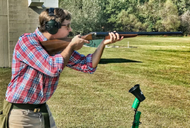Pump Or Semi Auto Shotgun?
Jun 26th 2023
A pump-action shotgun operates by manually cycling the action, requiring the shooter to physically pump the forend to eject the spent shell and load a fresh one. This manual operation has its advantages. First, pump-action shotguns are known for their reliability. The mechanical simplicity of the pump action makes it less prone to malfunctions or failures to feed, making it a dependable choice for shooters. Additionally, pump-action shotguns tend to be more forgiving when it comes to ammunition compatibility. They can handle a wide range of loads, including low-power or specialty rounds, making them versatile firearms for different shooting scenarios.
On the other hand, semi-automatic shotguns have gained popularity due to their ease of use and rapid follow-up shots. Unlike pump-action shotguns, semi-automatic shotguns use the energy from each shot to automatically cycle the action. This eliminates the need for manual pumping and allows for a faster rate of fire. For shooters who require quick follow-up shots, such as in bird hunting or competitive shooting, the semi-automatic shotgun can provide a significant advantage. The smooth cycling action also results in reduced felt recoil, making it easier to control and shoot accurately. However, it's worth noting that semi-automatic shotguns may require more maintenance and can be more sensitive to ammunition types, as some may not cycle reliably in certain models. Ultimately, the decision between a pump-action shotgun and a semi-automatic shotgun comes down to individual needs, shooting preferences, and the intended use of the firearm.

Is A Pump Or Semi Auto Shotgun More Reliable?
Reliability is a crucial factor to consider when selecting a shotgun, especially in high-stress situations such as self-defense or hunting. Both pump-action shotguns and semi-automatic shotguns have their strengths in terms of reliability.
Pump-action shotguns are often regarded as more reliable due to their manual operation. With a pump-action shotgun, the shooter has direct control over the cycling process. By manually pumping the forend, the shooter can ensure proper ejection of spent shells and reliable feeding of new rounds. This direct control reduces the likelihood of malfunctions or failures to feed, making pump-action shotguns a popular choice for those seeking a reliable firearm.
What Is The Effective Range Of A Pump-Action Shotgun?
The effective range of a pump-action shotgun largely depends on the ammunition and choke used. Buckshot, which consists of multiple large pellets, is commonly used for self-defense and close-range hunting. Its effective range typically ranges from 15 to 30 yards, with 20 to 25 yards being the optimal range for most defensive or hunting scenarios. However, it's essential to remember that shot spread increases with distance, making accurate shot placement more challenging at longer ranges.
For shooting slugs, which are single projectiles, the effective range of a pump-action shotgun can extend further. With rifled slugs and a properly sighted shotgun, accurate shots can be made at distances of 75 yards or more. However, it's crucial to understand that shotguns are not precision firearms like rifles, and their accuracy diminishes significantly beyond certain distances. The effective range of a pump-action shotgun, therefore, is limited compared to rifles but can still be suitable for a variety of hunting and self-defense scenarios within its effective range.

Is A Semi Auto Shotgun Good For Self Defense?
Semi-automatic shotguns can be excellent choices for self-defense purposes due to their specific advantages and capabilities. One significant advantage of semi-automatic shotguns is their ability to provide quick follow-up shots. In self-defense situations, where speed and shot placement are crucial, the semi-automatic action allows for faster target reacquisition and engagement. The reduced felt recoil of semi-automatic shotguns further enhances control and rapid shot delivery, especially for shooters who may have limited experience or physical strength.
Moreover, semi-automatic shotguns often have larger magazine capacities compared to pump-action shotguns. This allows for a higher number of rounds to be readily available, providing extended defensive capabilities before the need to reload. Additionally, many modern semi-automatic shotguns have accessory options such as extended magazines,red dot sights, or accessory rails, which can further enhance their effectiveness in self-defense scenarios.
Conclusion
In conclusion, the choice between a pump-action shotgun and a semi-automatic shotgun depends on individual needs, preferences, and the intended use of the firearm. Pump-action shotguns offer reliability and versatility, making them dependable for various applications. On the other hand, semi-automatic shotguns provide faster follow-up shots and increased magazine capacity, making them well-suited for quick target engagement.
While pump-action shotguns have a reputation for reliability, modern semi-automatic shotguns have improved significantly and can offer comparable reliability with proper maintenance and ammunition selection. The effective range of a pump-action shotgun is generally within close quarters, while semi-automatic shotguns can be effective for self-defense with their rapid shot delivery and extended magazine capacity.
Ultimately, the decision should be based on individual factors and thorough research. Both types of shotguns have their own strengths and limitations, and it's important to choose the one that best fits your specific requirements.



